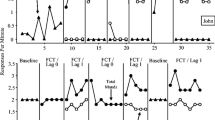Abstract
Standard functional analysis procedures may require modifications to assess idiosyncratic variables, such as adult compliance with mands. In the literature, the mands function is largely represented by individuals who vocally communicate idiosyncratic requests. Although effective treatment procedures have been published, schedule thinning has rarely been conducted. Using a reversal design, a mands functional analysis was completed with a 12-year-old nonvocal male. Results showed differentiated rates of challenging behavior. Treatment consisted of differential reinforcement via a chained schedule with signaled availability. During schedule thinning, low rates of challenging behavior were maintained.


Similar content being viewed by others
Change history
17 November 2020
Figure 2 did not have a data path of open circles depicted. Below is the corrected Fig. 2, with a more accurate figure caption.
References
Beavers, G. A., Iwata, B. A., & Lerman, D. C. (2013). Thirty years of research on the functional analysis of problem behavior. Journal of Applied Behavior Analysis, 46(1), 1–21. https://doi.org/10.1002/jaba.30.
Bowman, L. G., Fisher, W. W., Thompson, R. H., & Piazza, C. C. (1997). On the relation of mands and the function of destructive behavior. Journal of Applied Behavior Analysis, 30, 251–265.
Bullock, C. E., Fisher, W. W., & Hagopian, L. P. (2017). Description and validation of a computerized behavioral data program: “bDataPro”. The Behavior Analyst, 40(1), 275–285. https://doi.org/10.1007/s40614-016-0079-0.
Eluri, Z., Andrade, I., Trevino, N., & Mahmoud, E. (2016). Assessment and treatment of problem behavior maintained by mand compliance. Journal of Applied Behavior Analysis, 49, 383–387.
Normand, M. P., Severtson, E. S., & Beavers, G. A. (2008). A functional analysis of non-vocal verbal behavior of a young child with autism. The Analysis of Verbal Behavior, 24, 63–67.
O’Connor, J. T., Sorenson-Burnworth, R. J., Rush, K. S., & Eidman, S. L. (2003). A mand analysis and levels treatment in an outpatient clinic. Behavioral Interventions, 18, 139–150.
O’Neill, R. E., Horner, R. H., Albin, R. W., Sprague, J. R., Storey, K., & Newton, J. S. (2015). Functional assessment and program development for problem behavior (3rd ed.). Stamford, CT: Cengage Learning.
Owen, T. M., Fisher, W. W., Akers, J. S., Sullivan, W. E., Falcomata, T. S., Freer, B. D., et al. (2020). Treating destructive behavior reinforced by increased caregiver compliance with the participant’s mands. Journal of Applied Behavior Analysis, 53, 1494–1513.
Rossetti, L. M. (2006). The Rossetti infant-toddler language scale. Dallas, TX: Linguisystems.
Schmidt, J. D., Bednar, M. K., Willse, L. V., Goetzel, A. L., Concepcion, A., Pincus, S. M., et al. (2017). Evaluating treatments for functionally equivalent problem behavior maintained by adult compliance with mands during interactive play. Journal of Behavioral Education, 26, 169–187. https://doi.org/10.1007/s10864-016-9264-1.
Torres-Viso, M., Strohmeier, C. W., & Zarcone, J. R. (2018). Functional analysis and treatment of problem behavior related to mands for rearrangement. Journal of Applied Behavior Analysis, 51, 158–165. https://doi.org/10.1002/jaba.437.
Author information
Authors and Affiliations
Corresponding author
Ethics declarations
Conflict of Interest
All of the authors declare that they have no conflict of interest.
Ethical Approval
All procedures performed in this study involving human participants were in accordance with the ethical standards of the institutional and/or national research committee and with the 1964 Helsinki declaration and its later amendments or comparable ethical standards.
Informed Consent
Informed consent was obtained from the caregivers of the participant included in the study. The data that support the findings of this study are available from the corresponding author upon reasonable request.
Additional information
Implications for Practice
• This Brief Practice provides a framework to conceptualize assessment of challenging behavior maintained by access to adult compliance with nonvocal mands.
• This study replicates prior work in the area and extends the research by documenting effects for a nonvocal individual with challenging behavior maintained by access to adult compliance with mands. It provides a possible method for conducting schedule thinning within a multicomponent treatment package.
• Providers should carefully examine the relationship between communication and challenging behavior while conducting functional behavior assessments and consider both vocal and nonvocal communication.
Publisher’s Note
Springer Nature remains neutral with regard to jurisdictional claims in published maps and institutional affiliations.
Rights and permissions
About this article
Cite this article
Jeglum, S., Schmidt, J.D., Hallgren, M. et al. Assessment and Treatment of Challenging Behavior Maintained by a Nonvocal Mands Function. Behav Analysis Practice 13, 972–977 (2020). https://doi.org/10.1007/s40617-020-00486-z
Published:
Issue Date:
DOI: https://doi.org/10.1007/s40617-020-00486-z



